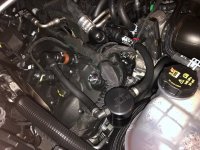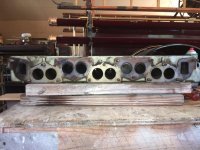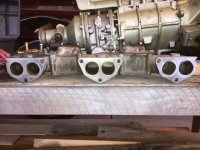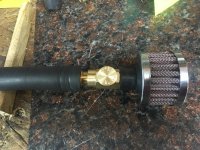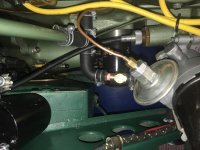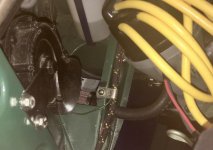Today i ran some tests to see how much pressure my PCV system might create in the crankcase. here is what i think.. hope it does not get too long. if it does, i apologize.
first off i changed my plumbing back to my first setup. John brought up a good point of maybe i was drawing the vacuum at the wrong place and could pull out too much oil. so in all of these tests the vacuum is being drawn from the valve cover. the only difference this time is i left the left side of the metal "T" on the valve cover plugged. So i was only pulling air thru the valve cover.
start up:
i put a hose on the side cover with a 1/4" fitting on it and a cap on the fitting so there was no vacuum leak.
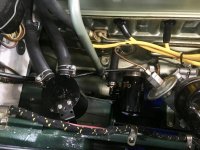
i started the car to let it warm up. the info i had said the vacuum in the crankcase should be measured with the engine hot and at idle. while it was warming up, i pulled the oil filler cap. that is quite a large hole but the engine idle never changed. this leads me to believe that the PCV valve we are using is probably well suited for my car. Since i am now under the impression the valve is only there to control air volume to the intake. So far so good.
first test:
i next hooked my vac gauge to the fitting you see in the pic above. keep in mind the vent pipe is plugged at the "T" so it is not pulling air. at idle and engine warmed up, i was pulling 5-6 in/HG. from what i have read i feel like this is too much vacuum. and i am not sure my dipstick is even sealed well. but i thought this would be a good base line. So this is where i started.
2nd test:
i capped the hose barb again and hooked my gauge to the dipstick tube. this was an issue as soon as i slid the hose over the tube sealing it. vacuum started climbing rapidly. FYI: at 9 in/HG the oil pan pops. it was at 10 and still climbing before i could get the rubber cap off the hose barb on the side vent. as soon as i pulled it off, the vac dropped below 1in/HG. i tired a few different pieces i could insert in the hose barb but i either got less than one inch vac or over 3 in/HG.
i know the articles i read said the vac at idle in the crankcase should be basically .4-.5 in/HG. But i am not sure how well i can measure that with my gauge. Which is why they probably measure it in in/H2O. just not enough distance between the marks to feel good with that. So i set my goal to get the vacuum in the 1-2 range hoping to get it as close to 1 as possible. i tried a number of different orifaces. shoving fittings of different sizes in hoses and checking the gauge. the 1/8" hose barb fitting i had would give me 2.5 in/HG (the hole size is actually about 5/64) and the 3/16 tubing i had would give me less than 1. so i figured i had to be somewhere in between.
third test:
the problem with the way i was tesing is it did not take in to account what might leak thru the dipstick. going with a suggestion here earlier, i changed my seal to include an oring at the bottom of my current seal. then put the dipstick back in. at the side cover, i installed a "T" again. on top of the "T" i connected my vac gauge and on the end of the "T", i put my oriface.
since i had not achived the number i wanted, i took the smaller 1/8" hose barb and drill a 9/64" hole thru it to make it a little bigger and hopefully get a reading closer to my goal. i also installed the barb in an air filter to make it as close to the final layout as possible. just in case it had some effect.
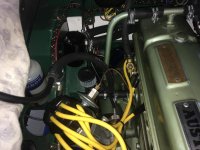
the hose you see in the pic coming up is going to the vac guage.
the new oriface gave me a reading of 1 in/HG. i pushed on the dipstick and held it to see if it made a difference and it did not. So i think i got the dipstick sealed decently. Oring did the trick.
while i had this hookup set, i tried changing engine speeds. idle, 1000 rpm, 2000 rpm, accel and decel. none of those changes made any difference in the vac reading. Another reason i think the PCV valve is probably a good choice. it must be compensating well for the change in manifold vacuum.
Conclusion:
So this is the way i am going to leave it... well as far as hook up anyway. i may change some hose lengths to get this a little better aligned. and i might change where the filter is sitting. i don't think the filter really needs to be that big. if i can get a smaller one, i might move it behind the brace so it is not so noticeable.
if i have the engine at idle now and pull the oil filler cap, i get a little vac noise but not near as much as before. So i am getting what i think is closer to the proper vacuum. and unless i find out something different, i think i am getting enough vacuum. there is also lots of info about the benefits of getting fresh air in to an engine. this is long enough so won't list here.
other than cleaning it up a little, i want to keep an eye on the oil catch can for a while to see how much oil it pulls in. i think with reducing the cranckcase vacuum it should not draw out as much oil. the only issue may be the oil slinging from the rocker assembly right below the "T". a baffle under the valve cover would greatly help that.
Thats it. All i got.
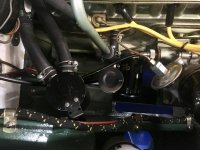
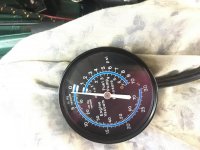
last setup and gauge reading.

 Hi Guest!
Hi Guest!

 smilie in place of the real @
smilie in place of the real @
 Pretty Please - add it to our Events forum(s) and add to the calendar! >>
Pretty Please - add it to our Events forum(s) and add to the calendar! >> 

